
(وَالسَّمَاءِ وَالطَّارِقِ * وَمَا أَدْرَاكَ مَا الطَّارِقُ * النَّجْمُ الثَّاقِبُ * إِنْ كُلُّ نَفْسٍ لَمَّا عَلَيْهَا حَافِظٌ) [الطارق: 1-4]، نحن أمام نجم وصفه الله تبارك وتعالى بأنه طارق وبأنه ثاقب: (وَالسَّمَاءِ وَالطَّارِقِ * وَمَا أَدْرَاكَ مَا الطَّارِقُ * النَّجْمُ الثَّاقِبُ) [الطارق: 3].
لقد
فسر العلماء هذه الآية قديماً على أنّها تتحدث عن كل النجوم، فجميع النجوم
لها ضوء ثاقب وإشعاع قوي، ولكن حديثاً ظهر ما يسمى بالنجوم (النيوترونية)،
ما هي هذه النجوم؟ ما هي قصتها؟ في عام 1967 رصد العلماء موجات راديوية
كهرطيسية من خلال بعض التلسكوبات الرادوية الموجودة لديهم، لقد التقطت
إشعاعات لنجوم مجهولة، في البداية ظن العلماء أن هذه الترددات الراديوية ما
هي إلا رسائل من كائنات مجهولة أو أنها شيء مجهول، ولكن بعد ذلك بقليل
تبين أنها عبارة عن نجوم تبث هذه الأمواج الراديوية بصورة دقيقة ومنتظمة.
وبعدما
قام العلماء بدراسة هذه النجوم دراسة دقيقة على مدى أكثر من ثلاثين عاماً
وجدوا بأن هذه النجوم أكبر من الشمس بعدة أضعاف. وتتشكل نتيجة انفجار
النجوم، فعندما ينفجر هذا النجم ويتهاوى على نفسه فإن مادته تتحول إلى
نيوترونات. ويقول علماء وكالة ناسا: إن هذه النجوم ثقيلة جداً حتى إننا لو
أخذنا كمية بحجم "مكعب سكر" سوف يزن 100 مليون طن، أي وزن جبل [6]، كذلك
فإن جاذبية هذه النجوم وبسبب كتلتها الهائلة أكبر 200 بليون مرة من جاذبية
الأرض [7]!!
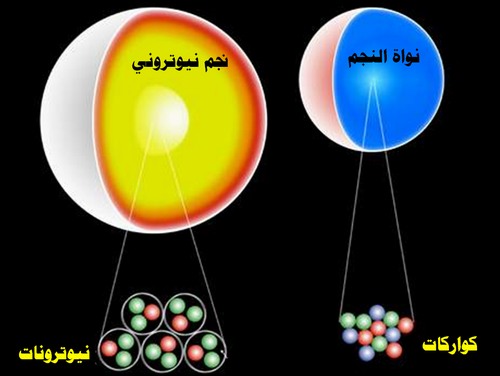
النيترونات
هي مكونات دقيقة داخل الذرة فنحن نعلم أن الذرة وهي أصغر وحدة بناء في
الكون تتألف من نواة، فيها جسيمات موجبة وهي البروتونات، وجسيمات أخرى
عديمة الشحنة هي النيوترونات. هذه النواة مغلفة بأغلفة الكترونية (طبقات من
الالكترونات تدور حولها) تماماً مثل المجموعة الشمسية حيث تكون الشمس في
المركز وتدور الكواكب من حولها. فالإلكترون: شحنته سالبة وهو موجود في
الغلاف الخارجي للذرة. والبروتون: شحنته موجبة وهو موجود في نواة الذرة.
وعندما يتحد الإلكترون مع البروتون وينصهر هذين الجسيمين الموجب مع السالب
فإن هذه العملية تحرر كمية كبيرة من الطاقة ويتحول هذان الجسيمان إلى جسيم
واحد هو النيوترون الذي لا شحنة لها. فالإلكترون السالب يتحد مع البروتون
الموجب ويندمجان وتختفي الشحنة وينتج جسم لا شحنة له، وهذا مبدأ عمل النجوم
النيترونية.
ما هو الطارق؟
يبدأ
هذا النجم بالدوران حول نفسه بشكل هائل، فيدور مئات الدورات في الثانية
مما يولد حوله مجالاً كهرطيسياً قوياً جداً، هذا المجال يولد أيضاً صوتاً
يشبه صوت المطرقة، لذلك فإن العلماء وجدوا أن أفضل تسمية لهذه النجوم هي
المطارق العملاقة، حتى إنهم يطلقون عليها في أبحاثهم هذا الاسم، ولكن
لماذا؟
لأنهم
وجدوا أن هذه النجوم تصدر أصواتاً تشبه تماماً صوت المطرقة، ولكن هنالك
بعض العلماء تساءلوا: كيف يمكن أن يكون الصوت حقيقياً، ونحن نعلم أن الصوت
لا ينتشر في الفراغ، فهذه النجوم بعيدة عنا جداً وتفصلنا عنها سنوات ضوئية
فكيف يصلنا هذا الصوت مع العلم أن الصوت يحتاج لوسط لكي يسير فيه، لأن
الصوت لا ينتشر في الفراغ.
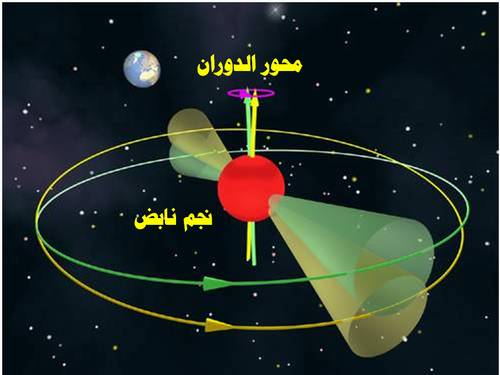
إن
هذه النجوم تصدر صوتاً حقيقياً، لو أننا اقتربنا منها لسمعنا هذه الأصوات،
إنها تصدرها وتنتشر في مجال معين حولها، ولكن بعد ذلك تختفي هذه الأصوات
ويبقى منها الأثر الراديوي لها، أي تبقى فقط الموجات الراديوية، والذي فعله
العلماء أنهم جاءوا بهذه التسجيلات وقاموا بردها إلى شكلها الأصلي، تماماً
مثل موجات الراديو، فالراديو يستقبل موجات ولا يستقبل أصواتاً، لأن الصوت
لا ينتشر آلاف الكيلومترات، ولكن يتم تحويل هذا الصوت إلى موجات راديوية،
يستقبلها هذا الجهاز ثم يعيد بناءها ويحولها إلى شكلها الأصلي، فنسمعها
أصواتاً، العملية ذاتها تحدث مع النجم الطارق.
ولكي
نؤكد صدق هذه الأبحاث فإن العلماء سجلوا هذه الأصوات وعرضوها من مواقعهم
العلمية، وهي أصوات حقيقية سجلتها الأجهزة، مع أن الصوت لا ينتشر في الفراغ
إلا أن الأجهزة تستطيع تسجيله بتقنيات خاصة، بعد تحليل الأشعة الراديوية
الصادرة عن النجم.
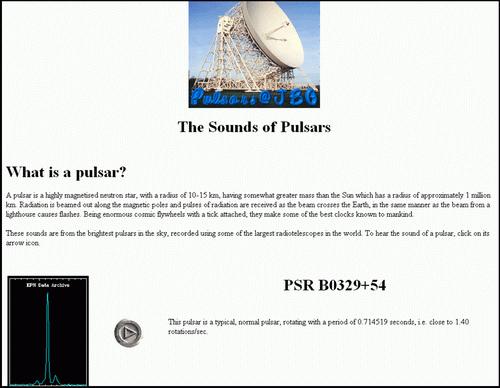
ولذلك فإن الله تبارك وتعالى سمى هذا النجم (الطارق)
وهنا أحب أن أشير إلى أن العلماء يسمونها النجوم النابضة، وهذه التسمية
غير دقيقة لأن العلماء ظنوا في بداية الأمر أن هذه النجوم تشبه نبضات
القلب، ولكن بعد ذلك تبين لهم أن التسمية الأدق هي تسمية مطرقة أو مطارق،
فأسموها المطارق العملاقة، وبالفعل فإن الصوت الذي تصدره هذه النجوم يشبه
تماماً صوت المطرقة.
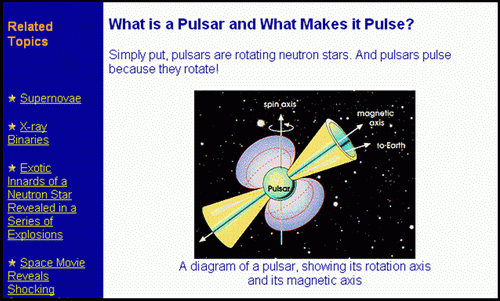
يؤكد علماء وكالة ناسا أن هذه النجوم تصدر أصوات نبض أو خفقان، وهذا ما يطرحونة من خلال موقعهم ويتساءلون عن سره فيقولون: What is a Pulsar and What Makes it Pulse? Simply put, pulsars are rotating neutron stars. And pulsars pulse because they rotate!
اعتراضات المشككين والرد عليها
يقول
المشككون إن الصوت لا ينتشر في الفراغ فكيف علمتم بأن هذه النجوم تصدر
صوتاً يشبه صوت المطرقة؟ ونقول كلامكم صحيح! فالصوت لا ينتشر في الفراغ
ولذلك نحن لا نسمع صوت هذه النجوم وهذا من رحمة الله علينا لأن صوتها لو
وصلنا لصم آذاننا على الفور!! ولكن العلماء بعدما حللوا الأمواج الراديوية
ودرسوا آلية عمل هذه النجوم وجدوا أنها تصدر هذه الأصوات، وهذا ما يقوله
علماء وكالة ناسا!
ففي بحث نشرته وكالة ناسا يؤكد فيه البروفسور Tod Strohmayer أثناء حديثه عن اكتشاف في عالم النجوم النيوترونية فيقول بالحرف الواحد:
"We
think this explosion, the biggest of its kind ever observed, really
jolted the star and literally started it ringing like a bell,"
وهذا
يعني أن الانفجار الذي رصده العلماء والذي تشكل بنتيجته هذا النجم هو أعنف
انفجار رآه العلماء حتى الآن، فقد أحدث هزة عنيفة للنجم وجعله يدق مثل
الجرس!
كما
يؤكدون أن هذه النجوم تبث إشعاعات هي الألمع من نوعها فهي تطلق أشعة تبهر
الأبصار وهنا نتذكر الوصف الإلهي لهذا النجم بأنه (ثاقب) وقد فسر المفسرون
هذه الكلمة بقولهم: النجم الثاقب أي اللامع، وهو ما يعبر عنه العلماء بكلمة
hyperflare أي ضوء يبهر الأبصار [9].
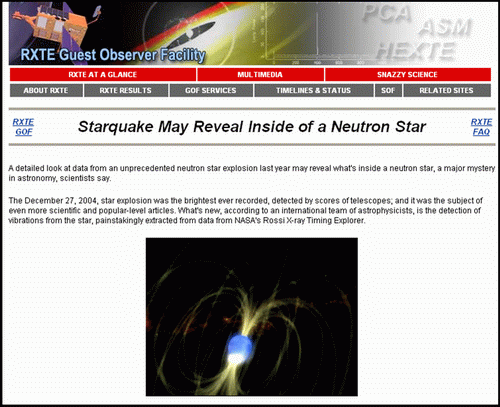
يؤكد البروفسور Richard Rothschild من
جامعة كاليفورنيا أن النجوم النابضة تنتج عن انفجارات النجوم وتبث كميات
هائلة من الإشعاعات التي تعتبر الأشد لمعاناً وهي تعمل مثل المطرقة التي
تدق، فيقول بالحرف الواحد: "This explosion was akin to hitting the neutron star with a gigantic hammer, causing it to ring like a bell,"
هذا الانفجار كان شبيهاً بضرب نجم نيوتروني بمطرقة عملاقة وهذا ما يجعل
النجم يدق مثل الجرس. ويؤكد هذا الباحث أن الضوء الصادر عن مثل هذه
الانفجارات عظيم جداً great flares فقد
بث هذا النجم خلال عشر ثانية ما تبثه الشمس خلال 150000 سنة من الضوء!!!
وهنا نتذكر كلمة (طارق) وكلمة كلمة (ثاقب) فهاتين الكلمتين دقيقتان جداً من
الناحية العلمية، أليس هذا ما فعله القرآن عندما عبر عن هذه النجوم
بكلمتين (الطارق... الثاقب)؟؟
ما هو الثاقب؟
بعد
دراسة طويلة لهذه المخلوقات الكونية وجد العلماء أن هذه النجوم تصدر موجات
أسموها موجات جذبية تشبه موجات الجاذبية الأرضية، ولكن أقوى بملايين
المرات، هذه الموجات موجات يصدرها هذا النجم النيوتروني، ويقول عنها
العلماء بالحرف الواحد (إنها تثقب وتخترق أي شيء تصادفه) حتى إن الكرة
الأرضية تُخترق بالكامل من قبل هذه الموجات التي تبثها النجوم النيوترونية
أو المطارق الكونية.
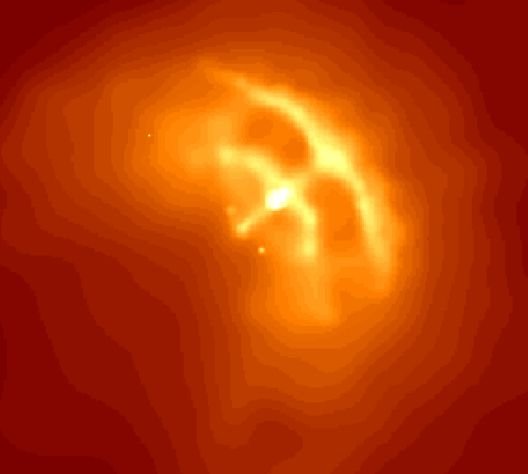
صورة
بالأشعة السينية لنجم نابض يبعد عنا 800 سنة ضوئية التقطتها وكالة ناسا
وعرضتها بتاريخ 9/6/2000 يبلغ قطر هذا النجم 12 كيلو متر. http://apod.nasa.gov/apod/ap000609.html
ولذلك
فإن الله تبارك وتعالى عندما سماها بالنجم الثاقب، فإن هذه التسمية دقيقة
جداً علمياً، ويستخدمها العلماء اليوم، ويقولون إنها تخترق أي شيء، حتى إن
هذه النجوم تصدر أيضاً أشعة كونية من مادة اسمها النيوترينو وهي جسيمات
صغيرة جداً لا شحنة لها، تبثها هذه النجوم وتصل إلى الأرض وتخترق الغلاف
الجوي، وتخترق أجسامنا، وتخترق الأرض بالكامل، حتى إنهم نزلوا إلى أعماق
البحار فوجدوا آثاراً لهذه الجسيمات الصغيرة (نيوتريونو) ونزلوا إلى أعمق
نقطة على سطح اليابسة ووجدوا آثاراً لهذه الجسيمات الدقيقة، ولذلك فإن كل
شيء تبثه هذه النجوم يعتبر ثاقباً وخارقاً لأي شيء.
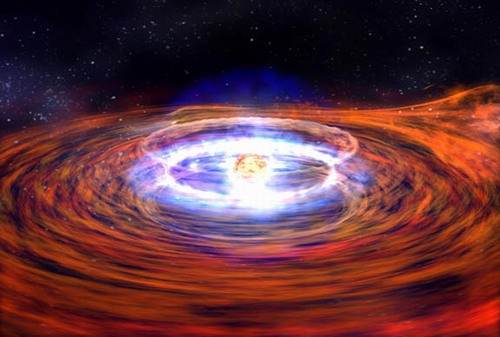
عندما
ينضغط النجم على نفسه، وترتفع درجة حرارته إلى ملايين الدرجات فإن هذه
الحالة تجعل الجسيمات تنصهر مع بعضها لتشكل النيوترونات ويصبح لدينا النجم
النيوتروني، ويتحول ذلك النجم الكبير الذي هو خمسة أضعاف كتلة الشمس والذي
يبلغ قطره ملايين الكيلو مترات، يتحول إلى نجم صغير لا يزيد قطره عن عشرين
كيلو متراً. فتخيلوا معي أن نجماً يبلغ وزنه خمسة أضعاف وزن الشمس، ويبلغ
قطره ملايين الكيلو مترات أنه فجأة يتحول إلى نجم نيوتروني، قطر هذا النجم
النيوتروني عبارة عن 20 كيلومتر فقط. المرجع: وكالة ناسا.
(b)- Pulsars are Piercing:
The following Scientific articles clearly demonstrate the piercing power of
the Pulsars:
Al-Thaqib (الثاقب) is derived from
Thaqb (الثقب).
Al-Thaqb(الثقب): means
الخرق النافذ
a piercing penetration.
Also, according to Arabic-English Dictionary, The Hans
Wehr Dictionary [6],
Page 103:
Thaqb (ثقب): To drill, to
pierce, to drill a hole, to
puncture.
Thuqbah (ثقبة):
A hole.
Article #1:
"A
pulsar is a spinning neutron star that forms from a
supernova that implodes and then explodes.
The implosion smashes together countless protons and electrons,
creating an extremely dense, massive star
composed entirely of neutrons.
The 'kick' created when the star 'bounces' from the implosion to the explosion
sets the new neutron star spinning away from the site of the supernova. It is
this rapid revolution that causes the characteristic pulsing." (Source)
Article #2:
"Neutrinos moving in the Universe carry information
about events in their place of origin as does the light.
Neutrinos are generated in stars
in thermonuclear synthesis.
Weakly interacting
neutrinos
easily penetrate all
matter on their way.
Outer layers of stars and atmosphere of Earth, even the Earth itself cannot
disturb neutrino observations. The same reason makes neutrinos hard to detect,
so neutrino telescopes are very large and expensive. They consist of large
volume of water with thousands of photomultipliers. Photomultipliers detect the
Cerenkov light cone from fast electrons and muons, which get their kinetic
energy in interaction with a neutrino in the detector. The detected radiation
enables to determine the flavour, energy and direction of the neutrino.
.........
Radio
pulsars are rapidly spinning, highly magnetized neutron stars
which emit beams of radio waves and are observed to pulse when the beam crosses
the Earth. They represent the end-point in the evolution of massive stars, and
are excellent laboratories for the study of the bulk properties of matter at
nuclear densities and beyond. Millisecond pulsars are old pulsars
reborn through accretion of matter from a companion star, spinning so fast
that the surface velocities approach the speed of light. Pulsars are
remarkable objects. In the quarter century since their discovery, they have had
a impact on many fields of science. Understanding their composition is a
challenge in nuclear and condensed-matter physics. Their elusive emission
mechanism is a complex problem in electromagnetics, atomic physics and particle
physics. Explaining their creation, evolution, and distribution is a classical
astronomical task. The greatest contribution of pulsars observations, however,
is their use as probes of other phenomena beyond pulsar physics. Pulsars provide
great insight into the character of the interstellar medium. They provide
fundamental beacons for astronometry, and they are also a most fertile ground
for tests of general relativity." (Source)
Article #3:
"Neutrinos are
elementary particles that often travel
close to the speed of light, lack an electric charge,
are able to
pass through ordinary matter almost undisturbed
and are thus extremely difficult to detect. Neutrinos have a minuscule, but
nonzero mass. They are usually denoted by the Greek letter ν(nu). Neutrinos are
created as a result of certain types of radioactive decay or nuclear reactions
such as those that take place in the Sun, in nuclear reactors, or when cosmic
rays hit atoms. There are three types, or "flavors", of neutrinos: electron
neutrinos, muon neutrinos and tau neutrinos; each type also has an antimatter
partner, called an antineutrino. Electron neutrinos or antineutrinos are
generated whenever neutrons change into protons or vice versa, the two forms of
beta decay. Interactions involving neutrinos are generally mediated by the weak
force. Most neutrinos passing through the Earth emanate from the Sun, and more
than 50 trillion solar electron neutrinos pass through the human body every
second.[1]"
(Source)
Article #4:
"Abstract. The resonant
cyclotron absorption model (Hoshino et al.1992, Gallant and Arons 1994) is very
successful in describing particle acceleration in plerions. A sensible
prediction of this model is the presence of a substantial amount of relativistic
protons in pulsar winds.
Although difficult to detect, these protons may show up through their
interactions either with the photons in the plerion environment or with the
thermal gas in the supernova ejecta. Inelastic proton-proton (p-p) collisions
are expected to be very effective in young objects, resulting in a copious
production of neutral and charged pions. Charged pions produced during the first
few hundred years after the supernova explosion may have time to decay into
muons, whose subsequent decay may provide an additional source of electrons and
positrons in these nebulae, that sums up to the pulsar input. These secondary
leptons evolve just as the pairs in the pulsar wind, and signatures of their
presence could be found, in principle, even in the synchrotron spectrum of older
objects. pp collisions may remain fairly efficient even in moderately old
objects resulting in the production of
TeV -rays and neutrinos.
We apply our calculations to the case of the Crab Nebula, the best studied
plerion insofar, and find that existing data already allow to infer interesting
constraints on the physical properties of the Crab pulsar wind.
...........
As we mentioned in the introduction, the estimate of the effective target
density, nt,
is the main uncertainty in our calculation. The distribution of the thermal
material, in all cases when it is observed, is actually far from uniform.
The matter of the ejecta penetrates the synchrotron
nebulae due to Rayleigh-Taylor instabilities,
giving rise to concentrations in the form of “filaments”."
(Source)
Article #5:
"Cosmic
rays are very penetrating and as
well as penetrating through the atmosphere they have also been detected under
the ground such as in the London Underground system as well as down deep mines."
(Source)
Article #6:
"Summary In traversing the expanding shell of the
supernova, pulsar-accelerated heavy nuclei will suffer collisions with the shell
gas which lead to attenuation, and to fragmentation. Since the attainable energy
decreases in time as the pulsar slows down, and the shell thins out, cosmic-ray
particles of the highest energy will be most strongly affected. On the example
of the Gunn-Ostriker model it is shown that 1) the attenuation reduces the
maximum energy of the particles
which penetrate the shell
to about 0.03 of the highest energy the pulsar can
produce,
2) the attenuation is stronger for heavy nuclei than for protons so that these
particles remain dominant, and 3) a substantial fraction (∼2.7·10−4 in relation
to protons) of L-nuclei in the
cosmic radiation is formed.
In addition it is shown that also the revised model provides abundant production
of L-nuclei in the shell gas, and that the absorber particle radiation
accelerates the shell to a modest degree only." (Source)
Article #7:
"Why study
pulsars at high energy?
– Beaming properties are different
—we believe gamma-ray beams are larger
—in any case, comparisons of radio and
gamma-ray
beaming fractions will give us a
better estimate of the fraction
of pulsars
that is observed
–
Gamma-rays are penetrating
—radio telescopes are “more sensitive” in the sense that they
detect (and will continue to detect) far more pulsars
—however, radio observations near the Galactic center are
difficult because of dispersion and scattering
– We get a better estimate of the pulsar birth rate/core
collapse supernova rate/massive star birth rate/nucleosynthesis rate both
locally and near the Galactic center." (Source)
Article #8:
"Abstract --
The hydrodynamical calculations of the
penetration of neutron star into the envelope of a
red giant performed by Terman et al.
(1995) are used to calculate the gravitational radiation that arises during the
formation of a Thorne-Zytkowa (TZ) object. It is shown that if the regime
of hypercritical accretion onto a neutron star with a strong magnatic field
(greater than or equal) 10^13 (10 to the power 13) G sets in, the possible
neutrino-emission anisotropy generates amplitude-modulated gravitational
radiation with a period that is multiple of the rotation period of the neutron
star (a "gravitational-wave pulsar"). The calculated
gravitational-wave signal from such a pulsar can be recorded by the LIGO-II
gravitational wave observatory over three years of observations from distances
smaller than 1 kpc. Such a pulsar can also appear in a supernova
explosion an din a merger of two neutron stars or a neutron star an a
black hole." (Source)
Article #9:
"PULSAR SPIN EVOLUTION,
KINEMATICS, AND THE BIRTHRATE OF NEUTRON STAR BINARIES
Z. ARZOUMANIAN, J. M. CORDES, I. WASSERMAN
Department of Astronomy, Cornell University, Ithaca, NY 14853-6801
arzouman@spacenet.tn.cornell.edu, cordes@spacenet.tn.cornell.edu, ira@spacenet.tn.cornell.edu
Submitted to
The Astrophysical Journal,
Nov. 18, 1998
ABSTRACT
From considerations of spin evolution and kinematics in the Galactic potential,
we argue that the pulsars
B1913+16, B1534+12, and B2127+11C may be younger than previously assumed,
and we find that a lower bound on the formation and merger rate of close double
neutron star binaries is 10-6.7
f -1
b
f
-1
d yr-1,
where fb
is the beaming fraction and
fd
accounts for the possibility that
the known NS-NS binaries are atypical of the underlying population (e.g., if
most such binaries are born with shorter orbital periods). If we assume no prior
knowledge of the detectable lifetimes of such systems, the rate could be as
large as ≃
10-5.0
f -1
b
f
-1
d
yr-1.
From both plausible bounds on
fb and
fd,
and a revision of the independently derived limit proposed by Bailes (1996), we
argue that a firm upper bound is 10-4
yr-1. We also present a
unifying empirical overview of the spin-up of massive binary pulsars based on
their distribution in spin period
P and spin-down rate P˙
, finding evidence for two
distinct spin-up processes, one dominated by disk accretion, the other by wind
accretion. We argue that the positions of binary pulsars in the
P-P˙
diagram can be understood if (1)
there exists a Galactic population of pulsars in double neutron star systems
with combinations of spin and orbital periods that have prevented their
detection in surveys to date; (2) recycled pulsars in wide-orbit binaries are
not born near the canonical spin-up line in the
P-P˙
diagram because they were
predominantly spun up through wind accretion; and (3) there exists a disfavored
evolutionary endpoint for radio pulsars with spin periods 5–30 ms and
P˙
>
10-19 s-s-1.
Subject
headings: binaries: close — gravitation— pulsars: individual (B1534+12,
B1913+16)
..................................
5. ACCRETION MECHANISMS
AND THE DISTRIBUTION OF
RECYCLED PULSARS IN P AND
P˙
Surveys over the last 16 years have been
sensitive to objects with P∼
>
1 ms to varying degrees. Certain
portions of the P-P˙ diagram have become populated as a result,
while others have remained empty. We argue that three of these unpopulated
regions, labelled
A,
B,
and C
in Fig. 1, provide insights into
the evolution of binary systems containing neutron stars. In particular, there
is a dearth of pulsars in region
B
where we would expect to find
inspiralling NS-NS binaries. We assess the significance of this and other
deficits below.
5.1. Region
A
There are no known selection effects to
prevent detection of pulsars in region
A:
objects with spin-down rates higher than the low-field millisecond pulsars would
likely be brighter and so more easily detectable. Still, no recycled pulsars in
the galactic disk are known above the spin-up line. We interpret this as a
qualitative validation of the Ghosh-Lamb spin-up line. We discount pulsars in
globular clusters, here and in the discussions to follow, because of their
uncertain spin-down rates and complicated evolutionary histories.
5.2. Region
B
Region
B
is below and to the right of the
known NS-NS systems, for 50ms∼
<
P∼
<
200ms (Fig. 1). A deficit of
known pulsars here can occur for three reasons, all of which likely play some
role:
1. NS-NS binaries born near the spin-up
line will coalesce before reaching region
B.
In Fig. 1, the spin-down tracks plotted for the three NS-NS systems end at lower
right at the expected coalescence time for each system.
Only B1534+12 penetrates into region
B
before merging.
2. For systems like
B1534+12, inspiral results in short orbital periods, and high orbital
velocities, within region
B,
and such pulsars have been selected against.
3. As the pulsars in these systems age,
their radio luminosities probably decay, making them more difficult to detect
(Van den Heuvel & Lorimer 1996)." (Source)
Article #10:
"Pulsars
are superdense neutron stars, the remnants left
after massive stars have exploded as supernovae.
Their powerful magnetic fields generate lighthouse-like beams of light and radio
waves that sweep around as the star rotates. Most rotate a few to tens of
times a second, slowing down over thousands of years.
However, some, dubbed millisecond pulsars, rotate
hundreds of times a second. Astronomers believe the fast rotation is
caused by a companion star dumping material onto the neutron star and spinning
it up. The material from the companion would form a flat, spinning disk around
the neutron star, and during this period, the radio waves characteristic of a
pulsar would not be seen coming from the system. As the amount of matter falling
onto the neutron star decreased and stopped, the radio waves could emerge, and
the object would be recognized as a pulsar." (Source)
لماذا أقسم الله تبارك وتعالى بهذه المخلوقات الكونية العظيمة؟
لنتأمل هذه السورة بشيء من التدبر والتأنّي: (وَالسَّمَاءِ
وَالطَّارِقِ، وَمَا أَدْرَاكَ مَا الطَّارِقُ، النَّجْمُ الثَّاقِبُ،
إِنْ كُلُّ نَفْسٍ لَمَّا عَلَيْهَا حَافِظٌ) [الطارق: 1-4]. تأملوا
معي كيف ربط الله تبارك وتعالى بين النفس والملائكة التي تحفظ علينا
أقوالنا فكل إنسان وكَّل الله له ملائكة تحفظ وتكتب كل كلمة ينطق بها، وكل
حركة يقوم بها، بل كل فكرة قد تخطر بباله: (إِنْ كُلُّ نَفْسٍ لَمَّا عَلَيْهَا حَافِظٌ) [الطارق: 4].
ويقول
العلماء اليوم: إن هذه النجوم النيوترونية أو الثاقبة تُصدر هذه الموجات
وتصدر هذه الطرقات بدقة مذهلة، حتى إنهم يعتبرونها من أدق الساعات الكونية
على الإطلاق، يعني هذه النجوم أدق من أي ساعة على الأرض، فهي تصدر هذه
الطرقات بصورة شديدة الانتظام، ولا تخطئ في عملها أبداً.
فكأن
الله تبارك وتعالى يخاطب الناس جميعاً ويقول لهم: كما أن هذه النجوم التي
خلقتها وحدثتكم عنها وعن عملها ودقتها، كما أنها دقيقة في عملها ولا تخطئ،
كذلك فقد وكَّلت عليكم ملائكة لا تخطئ في كتابتها أبداً، لا تخطئ في كتابة
أي شيء أبداً يصدر عنك أيها الإنسان، فكل شيء مكتوب ومحسوب، ولا يخفى على
الله من شيء في الأرض ولا في السماء.
وإذا ما تتبعنا سلسلة الآيات، نلاحظ أن الله تبارك وتعالى يحدثنا عن آيات أخرى أيضاً لنصل إلى هدف نهائي أبعد من هذا الهدف: (وَالسَّمَاءِ
وَالطَّارِقِ * وَمَا أَدْرَاكَ مَا الطَّارِقُ * النَّجْمُ الثَّاقِبُ *
إِنْ كُلُّ نَفْسٍ لَمَّا عَلَيْهَا حَافِظٌ * فَلْيَنْظُرِ الْإِنْسَانُ
مِمَّ خُلِقَ * خُلِقَ مِنْ مَاءٍ دَافِقٍ * يَخْرُجُ مِنْ بَيْنِ
الصُّلْبِ وَالتَّرَائِبِ * إِنَّهُ عَلَى رَجْعِهِ لَقَادِرٌ * يَوْمَ
تُبْلَى السَّرَائِرُ * فَمَا لَهُ مِنْ قُوَّةٍ وَلَا نَاصِرٍ *
وَالسَّمَاءِ ذَاتِ الرَّجْعِ * وَالْأَرْضِ ذَاتِ الصَّدْعِ * إِنَّهُ
لَقَوْلٌ فَصْلٌ) الله تبارك وتعالى أقسم بهذه المخلوقات: بالسماء
ذات الرجع، وبالأرض ذات الصدع، وأقسم بهذه النجوم، على أن هذا القرآن هو
القول الفصل، فكما أن هذه السماء لا تخطئ في عملها ولا يوجد هناك خلل واحد
في الكون، كذلك هذا القرآن لا يخطئ أبداً:
(إِنَّهُ لَقَوْلٌ فَصْلٌ * وَمَا هُوَ بِالْهَزْلِ * إِنَّهُمْ يَكِيدُونَ
كَيْدًا * وَأَكِيدُ كَيْدًا * فَمَهِّلِ الْكَافِرِينَ أَمْهِلْهُمْ
رُوَيْدًا [سورة الطارق].
ويحاول
العلماء اليوم التعرف من خلال هذه النجوم على طبيعة المادة في الكون وكيف
تشكلت، فهم يعتقدون أن نواة النجم الطارق تحوي جسيمات تسمى "كواركات" وهي
كتل بناء البروتون والنيوترون، ويقولون إن دراسة هذه النجوم تساعد على
معرفة أصل تشكل النجوم والمادة في الكون. ومن هنا ربما ندرك لماذا جاء
الأمر الإلهي للإنسان أن يبحث عن أصله: (فَلْيَنْظُرِ الْإِنْسَانُ مِمَّ خُلِقَ)
وكأن هذه السورة تربط بين أصل تشكل المادة والطاقة في الكون من خلال دراسة
هذه النجوم، وأصل الإنسان من خلال دراسة النطفة التي خُلق منها!
وهذا الارتباط يؤكد أن القرآن مترابط، أي هناك علاقة بين النجم الطارق وبين خلق الإنسان، فالنجم الطارق (وَالسَّمَاءِ وَالطَّارِقِ) هو دليلنا لمعرفة أصل المادة والطاقة، والماء الدافق (خُلِقَ مِنْ مَاءٍ دَافِقٍ) هو دليلنا لمعرفة أصل الإنسان فتأملوا معي هذا الترابط العجيب!!
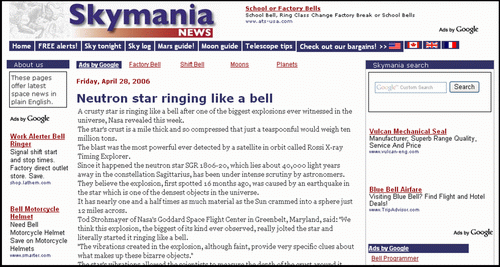
مقالة منشورة على أحد المواقع المهتمة بأخبار الفضاء بعنوان: النجوم النيوترونية تدق مثل جرس، وجاء في هذه المقالة: A
crusty star is ringing like a bell after one of the biggest explosions
ever witnessed in the universe, Nasa revealed this week.
وقفة تأمل
بعد
هذه الحقائق اليقينية هل هناك شك في أن النجوم النابضة تصدر صوتاً! وهل
هناك شك أن هذه الأصوات تشبه صوت المطرقة وأن العالم الأمريكي Richard Rothschild شبهها بالمطارق العملاقة gigantic hammer
وهل هناك شك أن هذه النجوم تصدر أشعة متوهجة هي الأكثر إشعاعاً؟ فكلمة
الثاقب كما قال ابن عباس هو المضيء (تفسير ابن كثير)، وفي معجم القاموس
المحيط: ثقب الكوكب: أضاء. إذاً النجم الثاقب هو المضيء اللامع، وهذه الصفة
تنطبق على هذه النجوم، والطارق هي صفة تنطبق أيضاً على هذه النجوم، ولذلك
فإن هذا البحث صحيح لا يتطرق إليه الشك، والله أعلم.
ثم
إن قول الملحدين إنكم تخالفون التفسير القديم للآية وما فهمه العرب قديماً
حيث قال قتادة: إنما سُمِّي طارقاً لأنه يُرى بالليل ويختفي بالنهار،
وسؤالنا: إذا كنا سنعتمد التفسير القديم فلا داعي للإعجاز العلمي! إن
الإعجاز العلمي هو فهم جديد لمعاني الآيات يتفق مع المعطيات العلمية
الحديثة لإثبات أن القرآن لا يناقض العلم. ونقول: لو اعتمدنا التفسير
القديم لجاء الملحدون ذاتهم وقالوا إن القرآن يحوي أخطاء علمية لأن هذه
النجوم حقيقة لا تختفي كما يقول التفسير! وبالفعل إنها تختفي بالنسبة لنا
(بسبب أشعة الشمس في النهار) ولكن الذي يخرج خارج الأرض يرى هذه النجوم
باقية ليلاً نهاراً! لذلك المفسرون لم يكن لديهم هذه الحقائق العلمية ولو
كانت لديهم لاستخدموها في تفسير الآيات.
نسأل
الله تبارك وتعالى أن يجعل في هذه الحقائق العلمية والكونية والقرآنية
وسيلة لهداية أولئك المشككين بهذا القرآن، وسيلة يزيدنا بها حباً وتعظيماً
لهذا الدين العظيم، واعتزازاً بانتمائنا لهذا الدين، ووسيلة أيضاً لأولئك
الملحدين كي يروا من خلالها عظمة هذا القرآن وصدق رسالة الإسلام.


الملاحدة يسيئون للعقل البشري
ردحذفالحمد لله
ردحذفشكرا لكم